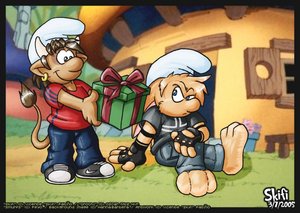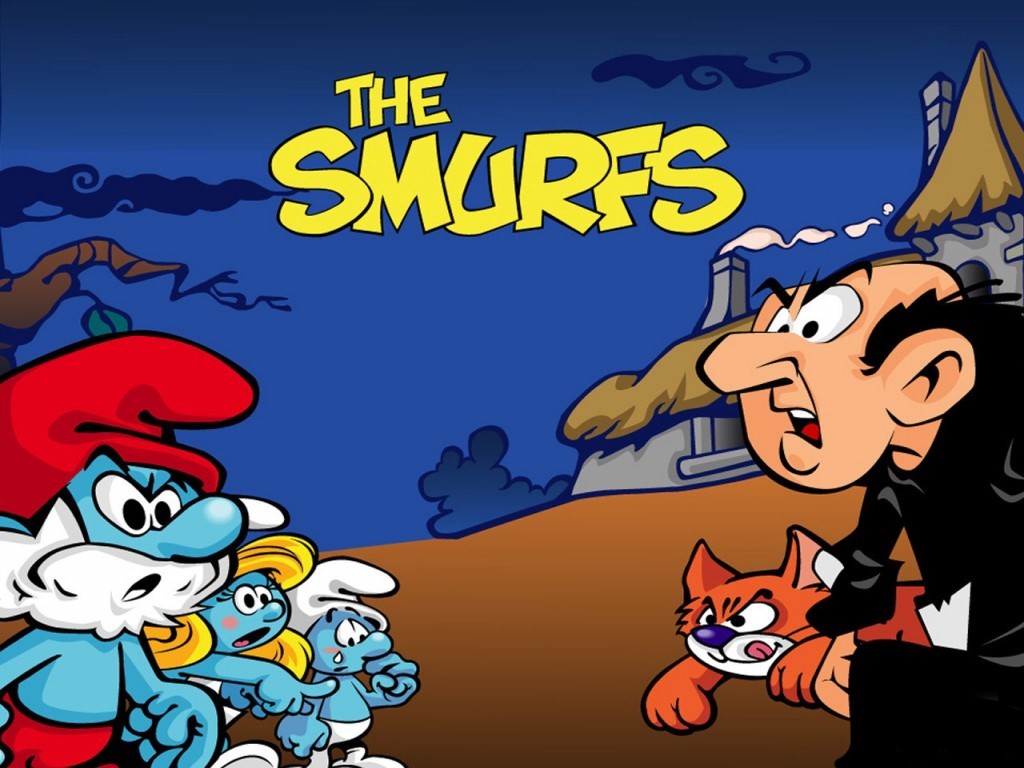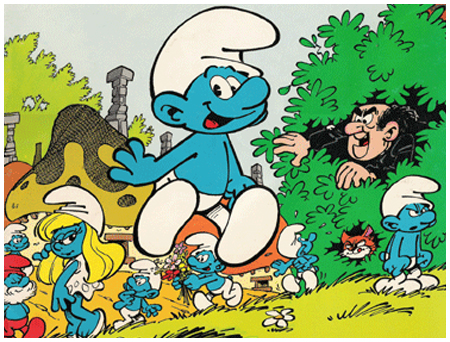Smurfs

The Smurfs (French: Les Schtroumpfs) is a comic and television franchise centered on a fictional group of small blue creatures called Smurfs, created by and first introduced as a series of illustrated comic strips by the Belgian cartoonist Pierre Culliford (also known as Peyo) on October 23, 1958. Culliford's initial comic first appeared in the Belgian magazine Spirou, and several decades later was adapted into an English language children's television series by Hanna-Barbera Productions, entitled The Smurfs.
Origins
The original term schtroumpf and the accompanying language came during a meal Peyo was having with his colleague and friend André Franquin in which, having momentarily forgotten the word "salt" Peyo asked him (in French) to pass the schtroumpf. Franquin replied: "Here's the Schtroumpf when you are done schtroumpfing, schtroumpf it back" and the two spent the rest of that weekend speaking in schtroumpf language.[2] The name was later translated as Smurf into Dutch, which was adopted in English.Johan et Pirlouit
At the time, Peyo was the creator, artist and writer of the Franco-Belgian comics series entitled Johan et Pirlouit (translated to English as Johan and Peewit), set in Europe during the Middle Ages and including elements of sword-and-sorcery. Johan serves as a brave young page to the king, and Peewit (Pirlouit, pronounced Peer-loo-ee) functions as his faithful, if boastful and cheating, midget sidekick.In 1958, Spirou magazine started to publish the Johan and Pirlouit story La Flūte ą six trous ("The Flute with Six Holes").[3] The adventure involved them recovering a magic flute, which required some sorcery by the wizard Omnibus. In this manner they met a tiny, blue-skinned humanoid creature in white clothing called a "Schtroumpf", followed by his numerous peers who looked just like him, with an elderly leader who wore red clothing and had a white beard. Their first appearance was published in Spirou on October 23, 1958.[4] The characters proved to be a huge success, and the first independent Smurf stories appeared in Spirou in 1959, together with the first merchandising. The Smurfs shared more adventures with Johan and Pirlouit, got their own series and all subsequent publications of the original story were retitled La Flūte ą six Schtroumpfs (also the title of the movie version of the story).
With the commercial success of the Smurfs came the merchandising empire of Smurf miniatures, models, games, and toys. Entire collecting clubs have devoted themselves to collecting PVC Smurfs.
Smurf Universe
The storylines tend to be simple tales of bold adventure. The cast has a simple structure as well: almost all the characters look essentially alike mostly male, very short (as tall as 3 apples high)[5]), with blue skin, white trousers with a hole for their short tails, white hat in the style of a Phrygian cap, and sometimes some additional accessory that identifies a personality. (For example, Handy Smurf wears overalls instead of the standard trousers, a brimmed hat, and a pencil above his ear.) Smurfs can walk and run, but often move by skipping on both feet. They love to eat Sarsaparilla (a species of Smilax) leaves, whose berries the smurfs naturally call smurfberries (the smurfberries appear only in the cartoon; in the original comics, the Smurfs only eat the leaves from the Smilax).
The male Smurfs almost never appear without their hats, which leaves a mystery among the fans as to whether they have hair. The animated series canon state that they may be bald: one episode of the Hanna-Barbera cartoon has Greedy Smurf removing his chef's hat to give Papa Smurf a pie he had concealed under it, revealing a bald head. Another episode, St. Smurf and the Dragon, shows Hefty Smurf's hat rising up off his bald head briefly as he and others slide to a stop. In "Spelunking Smurfs" Clumsy falls down a hole, his hat flying off revealing a bald head. Both Papa Smurf and Grandpa Smurf have full beards and hair visibly coming from under their hats above the earline. In The Smurfs and the Magic Flute, a Smurf took off his hat briefly for a polite gesture.
In the comics, the last page of the first album Les Schtroumpfs noirs (The Black Smurfs) shows Papa Smurf's hat blown off by an explosion, revealing his completely bald head (baldness that may simply be due to old age). In Le Schtroumpfeur de Bijoux (The Jewel Smurfer), Jokey Smurf gets very angry and defensive when a human tells him he should take off his hat.
The Smurfs fulfill simple archetypes of everyday people: Lazy Smurf, Grouchy Smurf, Brainy Smurf, and so on. All smurfs, with the exception of Papa, Baby, Smurfette, Nanny and Grandpa, are said to be 100 years old. There were originally 99 smurfs, but this number increased as new Smurf characters appeared, such as Sassette and Nanny. Smurfette is not one of the original smurfs because she was created by Gargamel, the evil wizard. [edit] Smurf village
When they first appeared in 1958, the Smurfs lived in a part of the world called "le Pays maudit" (French for "the Cursed Land"). To reach it required magic or travelling through dense forests, deep marshes, a scorching desert and a high mountain range.[14] The Smurf themselves use storks in order to travel long-distances, such as the kingdom where Johan and Peewit live and keep up-to-date with events in the outside world.[15]
In the Johan and Peewit stories, the Smurf village is made up of mushroom-like houses of different shapes and sizes in a desolate and rocky land with just a few trees.
However, in the Smurf series itself the mushroom-like houses are more similar to one another and are located in a clearing in the middle of a deep forest with grass, a river and vegetation. Humans such as Gargamel are shown to live nearby, though it is almost impossible for an outsider to find the smurf village except when led by a smurf.

